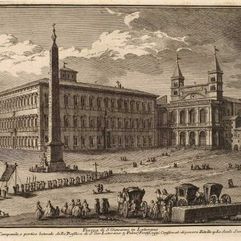

Giuseppe Vasi
1710 - 1782
Giuseppe Vasi was an Italian engraver and architect, best known for his vedute.
Biography
He was born in Corleone, Sicily and later, around 1736, moved to Rome. After a period of intense visits and studies, Vasi started to work as an engraver in the Calcografia Camerale Archived 2014-09-04 at the Wayback Machine, the main public institution of Rome devoted to engraving and etching, founded some years before by Pope Clement XII. His views for the Calcografia include panoramas of the Trevi Fountain and of the Spanish Steps.
Later on Vasi started to work on his own, producing and selling series of his views to a public made principally of grand tourists. The first series of akin consists in the Vedute di Roma sul Tevere, i.e. Views of the Tiber, circa 1743 and later adapted to become part of the Magnificenze di Roma antica e moderna. In these years Vasi also hosted in his workshop for a limited period of time the young Giovanni Battista Piranesi, his major pupil, who shaped here his technique as an engraver.
From 1747 to 1761 Vasi published a series of ten volumes including circa 240 engravings of vedute of Rome. He also created 15 tablet engravings of opera scenes designed by Vincenzo Re; some of which are part of the collection at the Victoria and Albert Museum in London.
Vasi played a major role as a cartographer and as writer as well. As a cartographer his major work remains the giant map of Rome, published in the early 1760s but conceived at least 20 years before; as an author, Vasi wrote nine out of ten books of the "Magnificenze" (II to X) and the "Itinerario Istruttivo". The "Itinerario", first published in the 1760s as well, turned out to be one of the most successful enterprises akin: translated in French and later in English, it was re-edited, modified and republished up to the mid-18th century.
Text courtesy of Wikipedia, 2024









